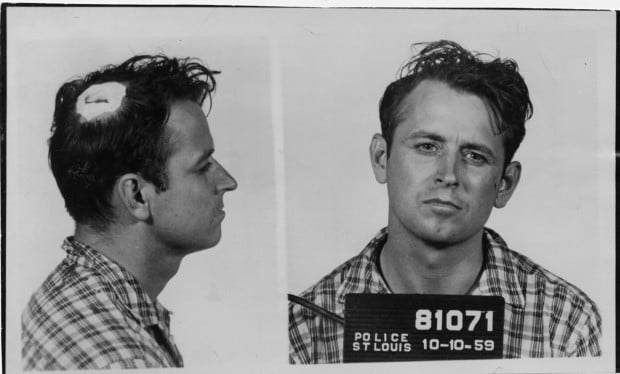ST. LOUIS ÔÇó He was a two-bit felon doing 20 years for robbery when he escaped from the Missouri State Penitentiary in a bread truck. The exploit made a small headline and was forgotten.
Roughly one year later, the Rev. Dr. Martin Luther King Jr. was murdered on a motel balcony in Memphis on April 4, 1968. Investigators found fingerprints in a rooming house across the street and on an abandoned Remington rifle.
On April 19, the FBI announced it had scanned 53,000 prints and made a hit ÔÇö the three-time loser who had escaped on the truck in Jefferson City.

An FBI wanted poster issued for James Earl Ray, including photographs of him taken in 1960 and, on the right, a doctored version of what he might have looked like in 1968. (Post-Dispatch)
A worldwide search was on for James Earl Ray, 40, a drifter who was born in Alton and spent pieces of his disjointed life in 51║┌┴¤. In 1959, he and an accomplice grabbed $190 in an armed robbery of a Kroger store at 3417 Ohio Avenue. Ray was arrested 20 minutes later at his apartment across from Lafayette Park.
People are also reading…
Ray had been in trouble since the sixth grade, when he stole school lunch money in Ewing, Mo., where his impoverished family lived for a time. He dropped out of the ninth grade, was booted from the Army and arrested for a burglary in East Alton because he had lost his shoes at the scene. Not the savviest criminal, he once tumbled out of a getaway car during a tight turn. He did time in Kansas and Illinois before returning to 51║┌┴¤ in August 1959.┬áHe robbed the store two months later and drew the 20.
His escape from the Missouri prison ÔÇö his third try ÔÇö took place on April 23, 1967. He was known inside as a racist, but there was nothing special about his hatred.
Scotland Yard detectives arrested Ray in London seven weeks after the FBI bulletin. He had used aliases and robbery to stay on the lam.
Ray's lack of distinction made it hard for many Americans to believe he could murder someone like King and get away all by himself. Conspiracy theories have lingered ever since. Ray fed the frenzy by pleading guilty of King's murder, taking a 99-year sentence and then quickly trying to recant.

A photo of James Earl Ray after his arrest for the Kroger robbery in 1959. The 51║┌┴¤ Police Department released it on April 19, 1968, when the FBI named Ray its suspect in the murder of the Rev. Dr. Martin Luther King Jr. two weeks before in Memphis. (The Associated Press)
There were claims of government cover-up and Mafia connections. One tale was of two segregationists from Imperial who put up $50,000 to murder King. The contract supposedly reached Ray by way of his brother's saloon, the Grapevine Tavern, 1982 Arsenal Street. Conveniently, the alleged money men already were dead.
Some members of King's family later said they didn't believe Ray was the killer. But numerous courts affirmed his conviction. Ray died a prisoner in Nashville, Tenn., in 1998 at age 70. In 2000, the U.S. Justice Department concluded again that Ray had acted alone.
James Earl Ray

In this 1968 photo released Wednesday, March 30, 2011, by the Shelby County Register's office, authorities escort James Earl Ray to the Shelby County jail in Memphis, Tenn. 

In this 1968 photo released Wednesday, March 30, 2011, by the Shelby County Register's office, a deputy, right, pats down James Earl Ray, in the Shelby County Jail in Memphis, Tenn.


James Earl Ray is escorted inside the Tennessee State Prison in Nashville on April 26, 1973, for his first interview with reporters since he pleaded guilty of murdering the Rev. Dr. Martin Luther King Jr. He was serving 99 years. He declined to discuss the murder during the interview. (UPI)









